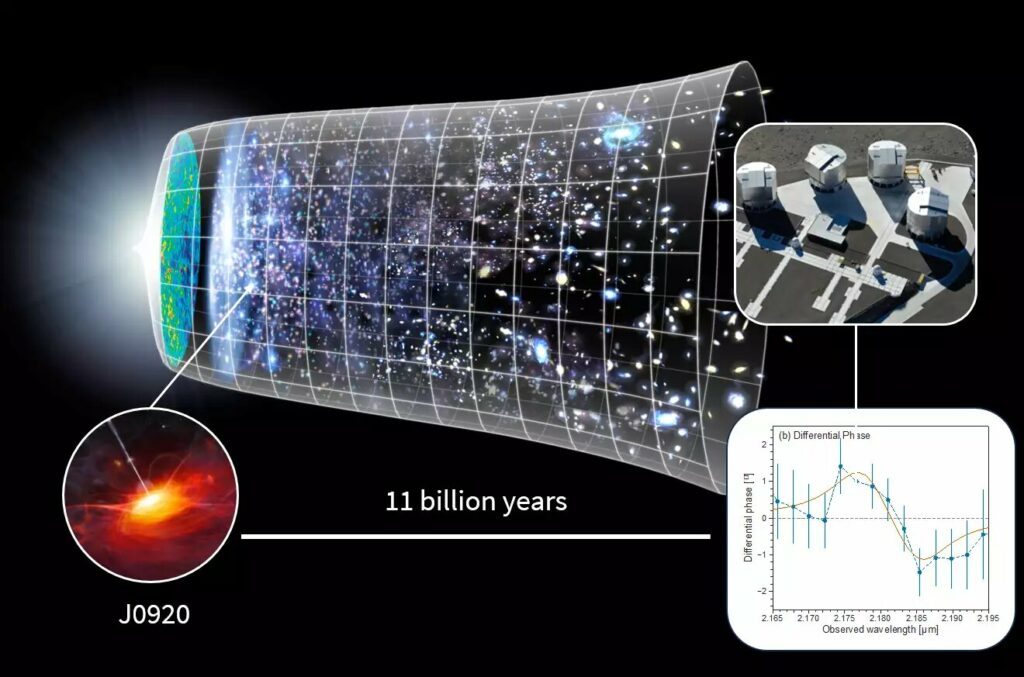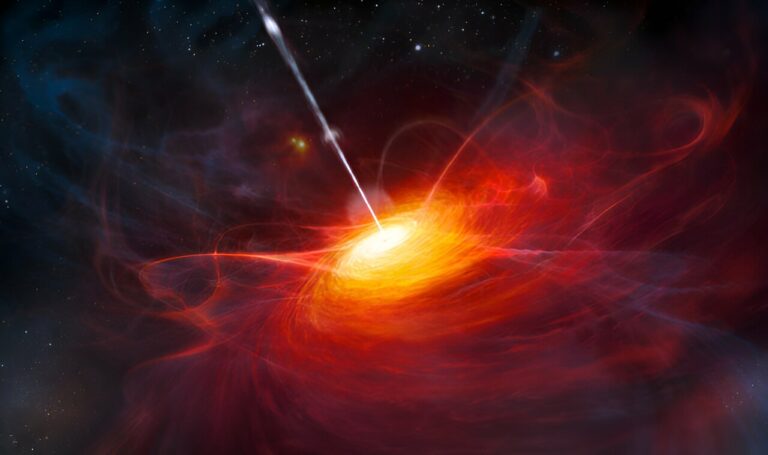Astronomers Discover Lower-Than-Expected Mass Influx to the Central Black Hole of an Early Universe Galaxy
A team of astronomers from the Max Planck Institute for Extraterrestrial Physics has utilized the upgraded GRAVITY-instrument at the Very Large Telescope Interferometer of the European Southern Observatory to determine the mass of a black hole in a galaxy that existed only 2 billion years after the Big Bang. Surprisingly, the black hole, with a mass of 300 million solar masses, is considered under-massive compared to its host galaxy. This intriguing discovery has left researchers pondering the possible explanations for this phenomenon. The findings of this study have been published in the esteemed journal Nature.
In the local universe, astronomers have observed a strong correlation between the properties of galaxies and the mass of the supermassive black holes located at their centers. This suggests a co-evolutionary relationship between galaxies and black holes. However, investigating this relationship during the early stages of the universe poses a significant challenge. Traditional direct methods of measuring black hole mass are either extremely difficult or impossible for these distant galaxies.
Despite the fact that these galaxies emit intense brightness (earning them the names “quasars” or “quasi-stellar objects” when they were initially discovered in the 1950s), their immense distance prevents most telescopes from resolving them.
Taro Shimizu, a staff scientist at the Max Planck Institute for Extraterrestrial Physics, explains, “In 2018, we achieved a groundbreaking feat by measuring the black hole mass of a nearby quasar using GRAVITY. However, we have now extended our reach to a redshift of 2.3, equivalent to a lookback time of 11 billion years.” This significant progress allows for a deeper understanding of the early universe and its intriguing cosmic phenomena.

GRAVITY+ presents a novel and precise approach to examining the growth of black holes during the critical epoch known as “cosmic noon.” This groundbreaking advancement in astronomy allows for the capture of images of black holes in the early universe with a level of clarity 40 times greater than what the James Webb telescope can achieve, as emphasized by Frank Eisenhauer, the director at the Max Planck Institute for Extraterrestrial Physics and leader of the GRAVITY instrument and GRAVITY+ enhancements development team. By combining the four 8-meter-telescopes of the ESO Very Large Telescope interferometrically, GRAVITY effectively forms a colossal virtual telescope with a diameter of 130 meters.
Through their research, the team successfully resolved the spatial movement of gas clouds encircling the central black hole of the galaxy, referred to as SDSS J092034.17+065718.0, as they rotate within a dense disk. This breakthrough enables a direct calculation of the black hole’s mass. Surprisingly, the black hole’s mass, measuring 320 million solar masses, is relatively lighter compared to its host galaxy, which boasts a mass of approximately 60 billion solar masses. This discrepancy suggests that the host galaxy experienced more rapid growth than the supermassive black hole, indicating a time lag between the growth of galaxies and black holes in certain systems.
Jinyi Shangguan, a scientist from the same research group, suggests that the evolution of this galaxy is most likely driven by strong supernova feedback. This feedback causes gas to be expelled from the central regions before it can reach the black hole at the center of the galaxy. According to Shangguan, the black hole can only begin to grow rapidly and catch up with the overall growth of the galaxy once the galaxy has reached a sufficient mass to retain a gas reservoir in its central regions, even in the face of supernova feedback.
In order to determine if this scenario is also the dominant mode of co-evolution for other galaxies and their central black holes, the team plans to conduct further high-precision mass measurements of black holes in the early universe. These measurements are necessary to gain a better understanding of the relationship between galaxies and their central black holes.
This article is republished from PhysORG under a Creative Commons license. Read the original article.
Do not forget to share your opinion with us to provide you with the best posts !




0 Comments